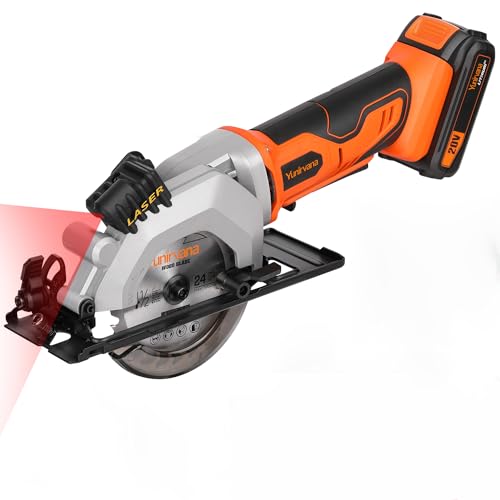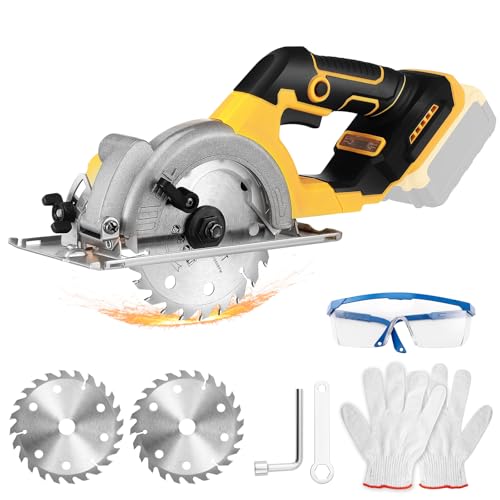Understanding the Mini Circular Saw: Features That Matter
Key Features to Consider
When we think about mini circular saws, the first thing that pops up is their size, which directly influences their portability and ease of use. These tools are typically lightweight and compact, making them ideal for both DIY enthusiasts and professional tradespeople. Another essential feature to look out for is the blade size, generally between 4 to 6 inches, which determines the depth of cut and the types of materials you can work with. It’s also crucial to consider the motor power, usually measured in amps, as higher wattage typically equates to better cutting performance for tougher materials.
Cutting Capacity and Bevel Adjustments
Cutting capacity is also important. It refers to the maximum thickness and angle a saw can handle with ease. Most mini circular saws offer adjustable bevel settings, which allow us to make angled cuts, perfect for creating precise miter edges on projects like crown moulding. A saw with a higher cutting depth allows us to tackle a variety of materials effectively, from plywood to softer woods, while still having the option for intricate cuts.
Safety Features
Safety is a priority when selecting a mini circular saw. We should look for features such as blade guards that automatically retract during use and safety locks that prevent accidental activation. These features greatly reduce the risk of accidents and ensure we can focus on our work without worrying about unforeseen injuries.
Choosing the Right Mini Circular Saw for Your Projects
Assessing Your Needs
Before we make a purchase, it’s essential to evaluate what type of projects we’ll be tackling. For instance, if we’re primarily cutting lightweight materials like laminate flooring or MDF, a lower amperage saw may suffice. Conversely, if we plan on working with denser materials such as hardwood or metal, investing in a higher-powered model will yield better results. Understanding the materials we frequently work with will help narrow down our options.
Brand Variations and Budget Considerations
Different brands offer varied features and price points. While some manufacturers may offer advanced features at a higher cost, there are also budget-friendly models that perform adequately for basic tasks. It’s wise to read user reviews and specifications to gauge whether a more economical option meets our expectations for performance and durability.
Consider Ergonomics
Comfort during use shouldn’t be overlooked. Features such as a rubberised grip and adjustable handle can greatly enhance our cutting experience, especially during prolonged use. We should look for a mini circular saw that feels good in hand, as this improves control and reduces fatigue, allowing us to work more efficiently.
How to Use a Mini Circular Saw Safely and Effectively
Preparation Before Cutting
Before we start cutting, it’s vital to ensure we’ve set up a stable workspace. Clear the area of any clutter and secure the material firmly, as movement can lead to inaccurate cuts or accidents. Always wear appropriate safety equipment, such as goggles and hearing protection, to shield ourselves from debris and noise.
Techniques for Effective Cutting
When using the mini circular saw, we should always let the blade reach full speed before starting our cut. We can apply steady pressure but avoid forcing the blade, allowing it to do the work. Keeping our hands clear of the cutting path and staying focused on the task can significantly enhance our safety and precision.
Post-Cutting Safety
After completing our cuts, it’s important to turn off the saw and allow it to come to a complete stop before setting it down. Never attempt to remove debris or inspect the blade while it’s still moving. Proper handling post-use ensures that we minimise risks and maintain control over our surroundings.
Essential Accessories for Your Mini Circular Saw
Selecting the Right Blades
Choosing the correct blade for our mini circular saw is vital for achieving the best cutting results. We should consider the material we are cutting: a fine-toothed blade is perfect for laminate, while a rough-cut blade works better for thicker woods. Having a selection of blades at our disposal allows us to switch depending on the project and improve finishing quality.
Useful Add-Ons
In addition to blades, there are a few essential accessories that can make our cutting tasks easier. A dust extraction system can help keep our workspace clean and improve visibility during cuts. Clamps are another important accessory, providing extra stability and security as we work, which leads to more accurate cuts.
Carrying Cases and Maintenance Tools
Lastly, investing in a sturdy carrying case protects our mini circular saw during transport and storage. It can safeguard it against damage, ensuring longevity. Furthermore, having maintenance tools on hand, such as brushes for removing dust and lubricants for the blade, can enhance performance and prolong the tool’s life.
Maintenance Tips to Ensure Longevity of Your Mini Circular Saw
Routine Cleaning
For our mini circular saw to function optimally, regular cleaning is essential. After each use, we should wipe down the tool, removing dust and debris from the body and blade to prevent buildup that could affect performance. Using a soft brush can be particularly effective for hard-to-reach areas without damaging delicate components.
Checking and Replacing Parts
Periodically, we should check the blade for sharpness and signs of wear. A dull blade can lead to less efficient cuts and requires more power, straining the motor. If we notice any wear, replacing the blade is a simple yet crucial maintenance step. We should also inspect the power cord for any damages, ensuring it is intact for safe use.
Proper Storage Guidelines
Storing our mini circular saw correctly prolongs its life. We should keep it in a cool, dry place, ideally in its carrying case, to protect it from moisture and dust. Avoid placing heavy items on top of it, which could warp the blade or damage other components, ensuring it’s ready for action whenever we need it.































